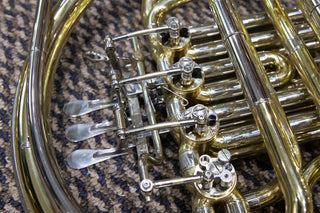The following notes and diagrams will tell you how to ensure that your instrument stays in top condition, avoiding expensive repair bills and allowing you to focus on making music.
MAINTAINING THE VALVES
All modern horns are fitted with rotary valves which, by their nature, are more complicated than the simple piston valves fitted to trumpets. To keep them working properly and to prevent wear, one needs a simple but regular maintenance routine. Different grades of oil are needed and the diagrams show where they are applied.
The bearings at the top and bottom of the valve spindle need regular oiling with a medium oil – (we recommend J. Meinlschmidt Bearing & Linkage #13.5 for most horns). Remove the valve caps one at a time, wipe away any old oil with a tissue and put one drop of oil on the top surface, where you can see the spindle turning in its collar. Then replace the valve cap taking great care not to cross the very fine threads. Don’t over tighten the cap, light finger tightness is all that’s needed. The oil under the top caps isn’t going anywhere except where it’s needed, but the bottom bearing is a different matter. Here a drop of J Meinlschmidt Bearing & Linkage oil #13.5 is needed in the small gap between the fixed collar and the rotating part of the valve; because this is exposed to air and open downwards, oil naturally runs away from its correct place, allowing the bearings to run dry. Apply oil to each bearing by squeezing a small drop into each gap; then turn the horn on its back and move the levers for a few seconds until the oil is well into the bearing. It is particularly important to oil these bottom bearings regularly.
While you are oiling under the valve caps check that the marks incised at 90 degrees line up when the valve turns. If the marks do not line up it will mean that the corks or rubber stops underneath have worn and that the valves will not be opening properly. It is possible to carefully replace these yourself, but you may find it easier to have a good repair technician do it for you.
Mechanical actions, whether hinged or ball & socket type need to be lubricated as well (again, we recommend J Meinlschmidt Bearing & Linkage #13.5 for most horns). There are three types of valve linkage in use, two of which are illustrated below. Not shown are articulated string action levers which only need oiling on the pivoting joint in the linkage (eg: Yamaha horns), in which case follow the advice for the other types. Even if your horn has the three main valves operated by string action, you will often find a mechanical linkage operating the thumb valve.
Proper oiling will reduce wear to linkages, along with reducing the noise, which is a symptom of wear. Apply a drop of oil onto each joint. Don’t worry if the oil doesn’t appear to get right into the joint immediately, as capillary action will soon take it where it is needed.
Over time slide grease and dust tend to collect in the valves, making them sluggish and sticky. Thin oil (Houghton Horns recommends J. Meinlschmidt Valve Oil #1 or Rotor Oil #11 for most horns) should be poured down the slides, and also onto the valves, will wash the residue. Begin by removing all of the valve slides, except the main tuning slides. Hold the horn so the open slides are vertical and apply one drop down each. Try to get the oil straight down the middle to avoid washing any slide grease left in the slides onto the valves. Then, still holding the horn up, move the levers until you feel the valves improve. Carefully discard the waste oil. This treatment should be done at least once a week.
LUBRICATION OF THE VALVE MECHANISM


Slides
It is very important that the slides move easily and are not allowed to become stuck. This is achieved with a suitable grease (Houghton Horns recommends J Meinlschmidt Slide Gel #7 for most horns). Wipe off any old grease with a tissue – a drop of thin oil on the tissue helps this – and ensure that there is no old grease building up in the ends of the slides. If the grease is applied to the whole length of the slide it tends to get pushed straight down to the end and onto the valves rather easily. Instead, take a dab of slide grease on the end of a finger or applicator and wipe a band of it round the middle of the slide, this will spread up and down the slide as it is inserted into the horn. Slides should be properly greased every couple of weeks.


